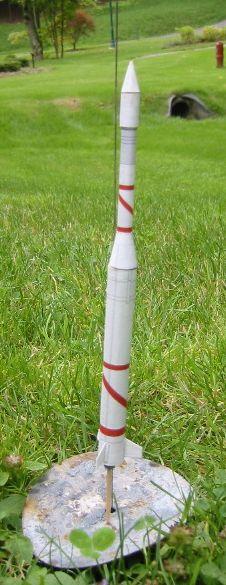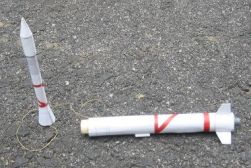Plan Diamant B French Sounding Rocket Plan
Lansbergen.net - Diamant B French Sounding Rocket {Paper}
Contributed by Clive Davis
| Construction Rating: | starstarstarstarstar |
| Flight Rating: | starstarstarstarstar_border |
| Overall Rating: | starstarstarstarstar_border |
| Manufacturer: | Lansbergen.net |
| Style: | Paper, Scale |

Brief:
This is a 1:144 paper scale model of the French rocket, Diamant B, first launched in 1970. Although Lansbergen's website is in Dutch, the instruction for the model are in English. The plans are for a static model, but with a few alterations, it can be made to fly using Micromaxx motors. My version separates at the shoulder, uses nose weight, and has a 6 mm motor mount installed.
Construction:
A list of what is needed to make the Diamant B:
- card stock
- yellow glue
- 6mm motor mount and motor block with extra card stock for centering rings
- Kevlar for shock cord
- 2 BBs for nose weight
All the parts for the rocket are on one page with the "instructions" on the other page. Construction is fairly easy. Roll the three different body tubes first, then roll the nose cone. After these have dried, I rolled the couplers that link the various parts of the rocket together. I must mention at this point that I was just building without much thought of converting the rocket to fly. Yellow glue was used exclusively, applying only tiny amounts with the end of a toothpick. After I had the entire rocket glued from nose cone to tail, I decided then to put in a motor mount and skip the directions for adding the nozzle/exhaust unit at the bottom. The important thing to remember when gluing the rocket together is to keep all the seams lined up so that they are on the "back" of the rocket. When I added the launch lug, I added it right to the side of the seam as well.
Next, I added the fins. My card stock was a little too weak, so my fins were a little flimsy at first. The fins are rather small and I began to wonder how they would perform once it came time to fly them.
I cut a small piece of 6mm tubing and put in a motor block. I then used scrap pieces of card stock in long thin strips and rolled them around the motor mount until it slid in to the tail of the Diamant B, making contact with the inner diameter of the rocket. I inserted the motor mount with a motor and did a swing test. After adding 2 BBs into the nose cone up through the tail, the swing test worked fine. Next I glued the BBs in the nose cone, using tissue paper and yellow glue as a bulkhead to keep them in place, and then glued in the motor mount.
Basically, if you know the alphabet and use common sense, it should be a piece of cake to make the rocket. The parts are labeled with letter names, and the guide on page 2 clearly show that part "B-C" clearly links part B with part C, and so on.
This is not really a CON, but the rocket is quite small, and rolling that little nose cone is a slight challenge. If you have never done a paper rocket before, I would recommend starting with something a little larger. Normally, a project like this I would rate a skill level 2, but because of the size of the rocket, I would put it at a skill level 2.5 - 3.
PROs: parts fit very well and do not need to be altered or cut in any way to get proper fit.
Finishing:
Since the rocket is pre-printed, all the markings and detail are already on the paper. All I had to do was add a little launch lug. Since my MMX launch lugs are styrene and the rocket is paper, I used a dab or two of CA glue to keep the launch lug on.
After the rocket was completely dry, I sprayed it with Rustoleum Lacquer (high luster coating). It made the paper translucent, allowing me to see a lot of the detail inside the rocket. At this point, I thought I had ruined the rocket, so I just let it sit in the sun and I forgot about it. Later on that day, I went outside and to my surprise, the rocket looked fine. The translucence disappeared. So, I gave it another 2 or 3 coats. After a day of allowing the lacquer to cure, it was ready for launch. The fins also became much more rigid from the lacquer treatment.
Construction Rating: 5 out of 5
Flight:
I first flew the rocket on August 7, 2004 at the high school where I work. The first launch was quite interesting. The motor (MMX II) fizzled, and the rocket jumped about a foot into the air, enough to clear the launch rod. At first, I thought that the rocket was too heavy, or just did not have the aerodynamics to make a good flight. Upon inspection, I noticed that the nozzle had blown clear out the motor. A little CATO! Well, there was no damage to the Diamant B, so I loaded up another MMX II. This time, it ripped off the pad, sailed into the air, and at motor ejection (just a little puff), it streamed to the ground, nose first. Good flight, but remember, I did not put any recovery in the rocket. I was hoping that it would tumble. Well, it didn't. The flight was successful, but the recovery needed a little work. When I picked up the rocket, I noticed no damage whatsoever. It is very light and the lacquer treatment added some strength to the paper.
I took the model home and used an X-Acto knife to cut around the lower half of the shoulder. I added a card stock coupler to the lower half so that the upper portion could sit on the lower half. I then added a Kevlar shock cord to both parts. I decided that since the rocket was so light, and yet rather large, nose-blow recovery would work fine.
I launched the Diamant B again on August 25, 2004, using MMX II motors again. The first launch of the day the Diamant took off at an angle. Although it flew well, it flew with more of a trajectory than I had hoped. Ejection occurred early (MMX IIs have very short delays), and I know that if Quest built 2 or 3 second delays on their MMX IIs, we would have great little motors. Recovery was fine.
The second flight of the Diamant B today was also on an MMX II. This time, I got the rocket to ascend fairly straight, but towards the end, it corkscrewed. Recovery was flawless.
So far, I have flown the rocket 3 times. Each flight was different, with all flights being average to above average. I am thinking about getting a longer launch rod for my MMX rockets, so that I can avoid some of the weathercocking and corkscrewing on lift-off.

Recovery:
Flight recovery worked fine once I installed the nose-blow/Kevlar idea into the rocket. I am interested that the rocket performed 3 different ways. Each flight was at least nominal (I don't like corkscrewing or weathercocking), and all flights were safe with ejection occurring way up in the air.
Flight Rating: 4 out of 5
Summary:
It's a fun little build and I like the idea that it's a scale model rocket out of paper that flies rather well despite the small fins.
PROs: attractive French rocket with lots of detail printed on the card stock. We often see American, Canadian, German and Russian scale rockets out on the pad. We don't see that many French or Polish rockets for that matter. Perfect rocket for MMX and if one really wanted to, it is possible to treat the bottom body tube as a minimum diameter tube for 13 mm motors. I assume it would need more nose weight, but it should really fly high (assuming those little fins work).
CONs: none, really. I wonder if the rocket would perform slightly better with larger fins. This would be fairly easy to do, just printing up the first page again slightly enlarged for the fins, but using the original size for the rest of the rocket. Considering this is supposed to be a static rocket plan, it flies pretty well.
Overall Rating: 4 out of 5
 |
 |